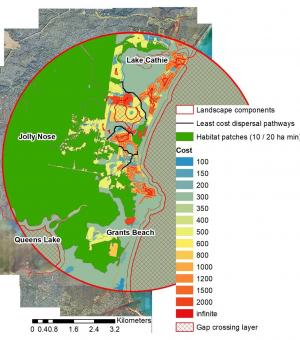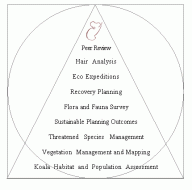![]()
Informed Planning Outcomes
Truly sustainable development ideally requires the effective integration of biodiversity assets into the landscape, be it as the setting aside of large natural areas for conservation, the identification of lands suitable for compensatory or offsetting purposes, landscape-scale biodiversity management plans or localised master planning exercises. Whatever the scale or objective, meaningful outcomes invariably require a well informed approach in order to provide demonstrably sustainable planning outcomes.
Biolink staff have extensive experience in all stages of the planning process, from the integration of ecological constraints into master planning studies, preparation of supporting statutory planning documents and the drafting of localized Development Control Plans.
Habitat Connectivity Analysis
 Habitat fragmentation is recognised as a key consideration for many threatened species. Accordingly, the identification and management of linkages connecting these habitat fragments is vital to the long-term sustainability of wild populations. At Biolink we run both broad and fine-scale connectivity analyses covering areas from 10 ha to more than 100,000 ha, enabling stakeholders to identify and prioritse areas for protection and restoration in order to maximise conservation outcomes, as well as modelling the outcomes of differing development scenarios. We do this using the Generalised Approach to Planning Connectivity at Local and Regional Scales (GAP CLoSR) framework, in concert with Graphab software. Amongst other things, GAP CloSR considers the ecological needs and movement characteristics of a given target species and the extent to which the landscape functions to impede and / or facilitate movement.
Habitat fragmentation is recognised as a key consideration for many threatened species. Accordingly, the identification and management of linkages connecting these habitat fragments is vital to the long-term sustainability of wild populations. At Biolink we run both broad and fine-scale connectivity analyses covering areas from 10 ha to more than 100,000 ha, enabling stakeholders to identify and prioritse areas for protection and restoration in order to maximise conservation outcomes, as well as modelling the outcomes of differing development scenarios. We do this using the Generalised Approach to Planning Connectivity at Local and Regional Scales (GAP CLoSR) framework, in concert with Graphab software. Amongst other things, GAP CloSR considers the ecological needs and movement characteristics of a given target species and the extent to which the landscape functions to impede and / or facilitate movement.



